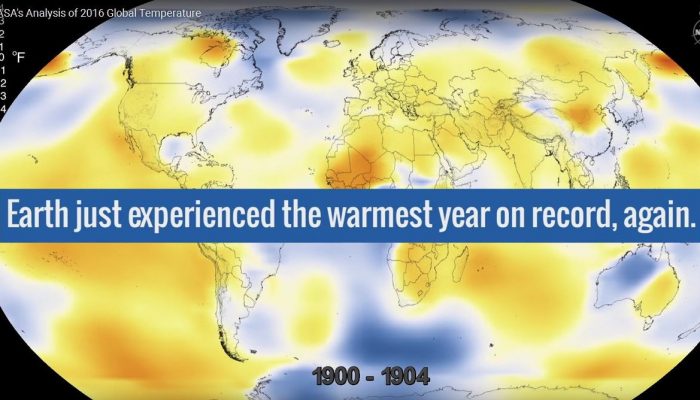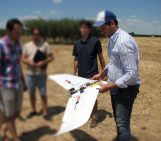
The start of the new year sees the launch of a new series here on GeoLog. Drawing inspiration from popular stories on our social media channels, as well as unique and quirky research news, this monthly column aims to bring you the best of the Earth and planetary sciences from around the web.
Major stories
One of the biggest stories of this month was the anticipated release of the average global surface temperatures for 2016. It probably wasn’t a great surprise to discover that newly released National Oceanic and Atmospheric Administration (NOAA), NASA and the UK’s MetOffice data showed 2016 was the hottest year on record. On average, temperatures last year were 0.99℃ higher than the mid-century mean. It marks the third year in a row that Earth has registered record-breaking temperatures and highlights a trend, as climate blogger, Dana Nuccitelli, explains in an article for The Guardian:
“We’re now breaking global temperature records once every three years”
This video, showing NASA global surface temperature record since 1880, illustrates the point clearly. There were no record breaking years between 1945 and 1976, but since 1980 there have been 12.
This month also saw the inauguration of the 45th President of the United States. A fierce climate-change denier, Donald Trump’s rise to power has many worried about the future of climate change policy at the White House. To shine a light on the realities of climate change in the face of a largely climate sceptic administration and despite the ever rising global temperatures, The Guardian dedicate 24 hours to reporting on how climate changes is affecting regions across the globe. Among the comprehensive coverage this collection of climate facts stands out.
And it turns out the fears about the newly elected administration may not have been unfounded. Earlier this week the US Department of Agriculture and other federal agencies issued a ban preventing its scientists from communicating with the press and public about their research findings; even on social media. The order has since been rescinded, but US- based scientists remain concerned. In response, the AGU has written a letter to federal agencies in the US defending the protection of scientific integrity and open communications.
Closer to home, central Italy was struck by a sequence of four earthquakes on 18th of January, with the largest registering a magnitude of 5.7. The epicentres were located close to the town of Amatrice – in a region already shaken by several strong, and sometimes devastating, earthquakes in 2016. Later that day, and following a period of very heavy snowfall, a deadly avalanche in the Apennines buried a hotel in the Grand Sasso resort area, which had also been affected by the earthquakes. Although some news reports were quick to suggest the avalanche had been triggered by the earthquakes, researchers will need more data and a more detailed analysis to make this connection.
What you might have missed
While we are on the topic of climate change, a newly published report by the European Environmental Agency is not to be missed.
“Climate change poses increasingly severe risks for ecosystems, human health and the economy in Europe.”
The document assesses the latest trends and projections on climate change and its impacts across Europe. While the effects of increasing temperatures will be felt across the continent, Southern and south-eastern Europe is projected to be a climate change hotspot with the forecasts showing the region will bear the brunt of the impacts.
A powerful 7.9 magnitude earthquake struck off the coast of Papua New Guinea on 22nd January. While the USGS estimated there was a low risk to property, tsunami warnings were issued across the South Pacific. In the wake of the tremor, the Incorporated Research Institutions for Seismology (IRIS) tweeted this neat ground motion visualisation of the earthquake waves.
A study published in Nature and summarised in Eos, highlights that while overt discrimination of women in the geosciences has not been as prevalent in recent years, many female scientists are still subject to subtle and unconscious bias leading to barriers to success in the geosciences.
Five links we liked
- NOAA’s new GOES-R satellite for weather monitoring returned its first stunning photos of planet Earth – here are six reasons why the data it will acquire matter.
- Snow fell in the Sahara for the first time in 37 years! This photogallery shows the usually red sand dunes of the desert covered in a sprinkling of white snow.
- Scientist at The University of Cambridge have published the first global map of flow within the Earth’s mantle, showing that the surface moves up & down “like a yo-yo”.
The EGU story
At the EGU, the highlight of the month is the number of abstracts we received from researchers wishing to present and discuss their science at the EGU 2017 General Assembly. With over 17,500 abstracts, and an improved set-up to accommodate the high number of expected participants, the conference promises to be the largest and most exciting to date. We look forward to welcoming everyone in Vienna on 23–28 April!
And don’t forget! To stay abreast of all the EGU’s events and activities, from highlighting papers published in our open access journals to providing news relating to EGU’s scientific divisions and meetings, including the General Assembly, subscribe to receive our monthly newsletter.




